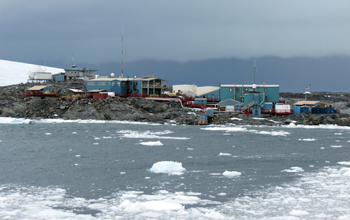Multimedia Gallery
Palmer Station, smallest of three U.S. Antarctic stations
Palmer Station is the smallest of the United States' three Antarctic research stations, with a peak population of 44. Because open water prevails there much of the year, wildlife is prolific, and research focuses on biology and the marine ecosystem.
The buildings pictured from left to right are: the Terra Lab; the garage, warehouse, recreation (GWR) building, which also houses the power plant, station store, medical clinic and some dormitory rooms; the biology lab (BioLab), which contains the cafeteria and kitchen, offices, laboratories, aquarium and some dormitory rooms; and the boathouse.
The National Science Foundation runs the U.S. Antarctic Program (USAP). In addition to maintaining three U.S. research stations on the continent, USAP supports research projects in an array of scientific disciplines including, for example, aeronomy and astrophysics, biology and medicine, geology and geophysics, glaciology, and ocean and climate systems. Outreach such as the Antarctic Artists and Writers program and education programs are also supported. For more information about USAP, visit the program's website Here. [Note: Please see special restrictions regarding use of this image, below.] (Date of image: Dec. 4, 2011)
Credit: Elisabeth Soued
See other images like this on your iPhone or iPad download NSF Science Zone on the Apple App Store.
Special Restrictions: [Note: Any commercial use of this image requires the photographer's permission.]
Images and other media in the National Science Foundation Multimedia Gallery are available for use in print and electronic material by NSF employees, members of the media, university staff, teachers and the general public. All media in the gallery are intended for personal, educational and nonprofit/non-commercial use only.
Images credited to the National Science Foundation, a federal agency, are in the public domain. The images were created by employees of the United States Government as part of their official duties or prepared by contractors as "works for hire" for NSF. You may freely use NSF-credited images and, at your discretion, credit NSF with a "Courtesy: National Science Foundation" notation.
Additional information about general usage can be found in Conditions.
Also Available:
Download the high-resolution JPG version of the image. (4.4 MB)
Use your mouse to right-click (Mac users may need to Ctrl-click) the link above and choose the option that will save the file or target to your computer.



